What are Indoor Plants?
Let’s imagine the way a small green plant can completely transform a room’s mood. The air seems fresher, quieter, and more vibrant. That is the simple magic of indoor plants for home. They are not mere ornaments; they are living things that purify the air, balance energy, and provide us with a feeling of being connected to nature. These plants are suitable for indoor growth, so they can thrive even in urban homes where a garden outdoors cannot be created. From leaf greens to flowers, there is a variety for every type of home.
Types of Indoor Plants (Flowering Plants, Succulents, Cacti, etc.)
There are several types of indoor plants, each having a special function in making your living space vibrant:
Flowering Plants (Jasmine, Anthurium)
Flowering plants such as Jasmine fills the atmosphere with a soothing scent, whereas Anthurium provides dramatic color with its vibrant red flowers. Both are excellent for infusing serenity into quiet niches.
Succulents (Aloe Vera, Echeveria)
Succulents such as Aloe Vera not only endure with little attention but also possess healing qualities. Echeveria, with rosette form, is cherished for being compact and ornamental.
Cacti (Golden Barrel, Bunny Ear Cactus)
Cacti such as Golden Barrel excel with rounded appearance, and Bunny Ear Cactus charms with paddle-shaped stems. Both endure less water and are low-maintenance.
Tropical Foliage (Ferns, Philodendron)
Tropical leaves such as Ferns prefer moist areas and form a soft green blanket, while Philodendrons are climbing plants that add a lush tropical atmosphere to the interior.
By knowing these types of indoor plants, you are able to choose ones that suit your lifestyle, whether flowers, foliage, or hardy ones that require minimal attention.
Best Plants for Home
In selecting the best plants for home, it is helpful to consider what each plant contributes to your environment. Some bring prosperity, some clean the air, and many just make rooms feel more vibrant.
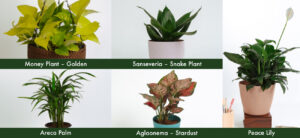
- Money Plant: Frequently linked with good fortune and prosperity, this is one of the most well-known options for homes.
- Snake Plant: With tall, vertical leaves, it’s a resilient choice that will survive on neglect. It also cleanses air by releasing oxygen during the night.
- Peace Lily: Known for its elegant white flowers, it’s a much-heralded air-purifying plant.
- Areca Palm: A tropical gem that brings greenery and assists in balancing humidity in dry rooms.
- Aglaonema: Nicknamed the “colorful plant,” its pink and red varieties instantly brighten corners with vibrant shades.
Together, these best plants for home bring charm, freshness, and practical benefits, making them favorites in many living spaces.
Easy Low-Maintenance Indoor Plants
Not everyone of us is in a position to give time and energy to demanding plants, and hence low-maintenance indoor plants are such a lifesaver. These plants need minimum attention and yet make your house look green and beautiful:

- Philodendron: A fast-growing climber that can climb up a trellis or spill down a pot, forgiving changing light conditions.
- Snake Plant: Nearly impossible to kill, it thrives on hardly any water and stays green and robust.
- ZZ Plant: A resilient plant that can handle low light and infrequent watering, ideal for busy lifestyles.
- Calathea: Adorned with its striped leaves, it merely requests periodic misting to remain in good condition.
- Cyclamen: A flowering plant that flowers beautifully during colder months, providing color with minimal care required.
These low-maintenance indoor plants enable even the busiest individuals to appreciate greenery without worrying about daily maintenance.
Which Indoor Plants Work Well for Small Living Spaces?
City living typically implies small rooms, but that doesn’t prevent you from having plants. These species are ideal for a flat, studio, or shared apartment:
- Cactus: Can be placed comfortably on a shelf or a desk and doesn’t need much watering.
- Ixora Yellow: Small, bright-flowering plant that adds color without occupying much space.
- Succulents: Perfect for windowsills, shelves, or coffee tables, particularly when planted in tiny ceramic pots.
- Adenium (Desert Rose): A compact tree with gorgeous pink flowers, beautifying small spaces.
Even in compact houses, these plants bring a lively, invigorating ambiance without requiring too much space.
How Do You Care for Indoor Plants?
Taking care of houseplants is easier than it appears. By following a few simple rules, your plants can live for many years:
- Watering: Don’t water at the same time every week. Instead, test the soil. If the top layer is dry, water them. Never overwater, as this can kill the roots.
- Light: Various plants require varying light. Some prefer direct, bright sunlight, while others like partial shade.
- Humidity: Tropicals do well if occasionally misted, as this freshens up their leaves in dry indoor conditions.
- Pruning: Trimming regularly clears dead leaves and makes the plant stronger.
- Repotting: Repotting every few years provides more room for the roots and keeps the plant healthy.
For further instructions on how to tend to indoor plants, you may refer to this blog, How to Care for Indoor Plants
FAQ
What is the best kind of indoor plant fertilizer to use?
Indoor plants do not require heavy feeding, but they do appreciate the appropriate fertilizer at the appropriate time. A balanced liquid fertilizer which contains an equal amount of nitrogen, phosphorus, and potassium is usually the safest option. Nitrogen will support leaf growth, phosphorus for roots and flowers, and potassium for general plant health. Apply it once every six to four weeks in the growing season (spring and summer). Do not over-fertilize, as too much can cause the roots to burn and do more damage than good.
How do I get rid of bugs on indoor plants?
Spider mites, mealybugs, and aphids are also frequent houseplant pests but can be controlled with a little patience. Begin by quarantining the infested plant so bugs will not spread. Wipe leaves gently with a damp cloth to remove easy-to-spot bugs. For more resistant infestations, a spritz of mild soap and water will prove useful. Natural products such as neem oil are non-toxic and gentle enough for ongoing prevention. Ongoing monitoring of your plants, particularly underneath the leaves, catches them in the early stages before they become a big issue.
How do I know when to water my indoor plant?
The secret to watering is to water the plant when it needs it, not necessarily by the calendar. One of the simplest tests is the “finger test”: stick your finger in the soil about an inch. If the soil feels dry, it is time to water. Each plant is different. Succulents and cacti prefer drier soil, while tropical plants like Calathea or Peace Lily enjoy more consistent moisture. Watch for signs: drooping leaves usually indicate thirst, while yellowing leaves may mean overwatering. Over time, you’ll develop a rhythm that works for each plant.
Can indoor plants reduce stress?
Yes, numerous studies have established that being exposed to plants can serenade the mind and body. House indoor plants lower stress levels by improving air quality, dampening noise, and offering a natural, soothing setting. Caring for plants also gives people a feeling of accomplishment and purpose, which is psychologically rewarding. That is why so many individuals resort to indoor gardening as a means of relaxation.
Which plant absorbs negative energy?
There are plants that are said to draw positivity and trap negative energy. The white-blooming Peace Lily tends to represent balance and harmony, the Snake Plant being a powerful defensive plant against unwholesome energy. Money Plants are believed to attract prosperity and ward off negative energy. Although the science of “energy” is more cultural and folkloric, most folks feel that these plants shift the mood of a space for the better.
Which plant is not good for home according to Vastu?
As per Vastu, not all plants are suited for indoor locations. The most widely avoided plant is the cactus. With its pointed thorns, it is believed to instill disagreement and tension in a relationship. Plants with dry or thorny looks are also discouraged indoors. But cactus can be placed on balconies or outdoor areas if you love them, they might just not be ideal for living rooms or bedrooms if you are a Vastu believer.
Which plant is best for a bedroom?
Bedrooms require plants that are soothing, easy to maintain, and healthy during the night. The Snake Plant is great because it emits oxygen even after dark, which improves air quality while you sleep. Peace Lily is also a good choice, as it cleanses toxins from the air and has a soft, calming appearance. Aloe Vera is also effective, with its healing and oxygen-producing qualities at night. These are small, low-maintenance plants that easily fit most windowsills or bedroom corners.
Which plant gives oxygen 24 hours?
All plants give oxygen in the day, but there are a few that do the same during the night. Snake Plant, Areca Palm, Aloe Vera, and Tulsi (Holy Basil) are famous for this very unique ability. Having them indoors provides a continuous supply of fresh oxygen throughout the day and night. That is why these are highly suggested for bedrooms, study rooms, or any room where you sit for long hours. They do not just enhance air flow but also provide fresher and more breathable air.



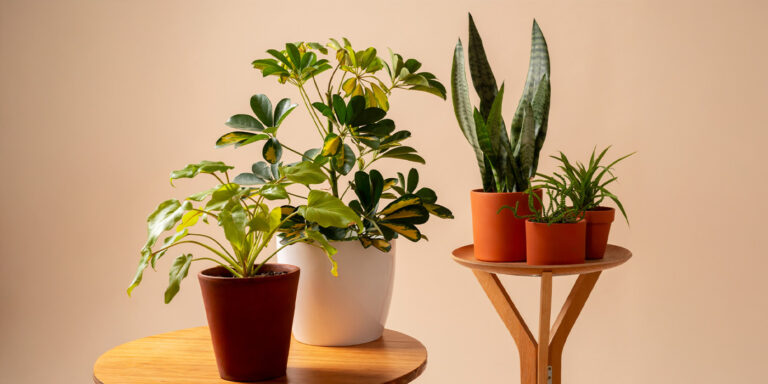

 Anthurium - red
Anthurium - red 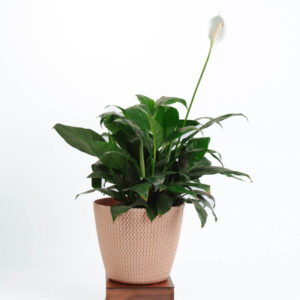 Peace Lily
Peace Lily  Pedilanthus
Pedilanthus  Bundle of succulents - Assorted variety of 12 succulents
Bundle of succulents - Assorted variety of 12 succulents  Cactus
Cactus  Succulent
Succulent 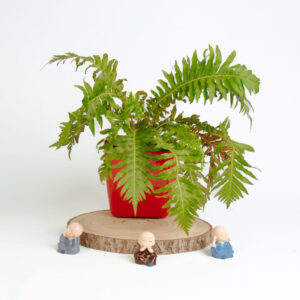 Boston Fern
Boston Fern  Cryptanthus
Cryptanthus  Kalnchoe red
Kalnchoe red 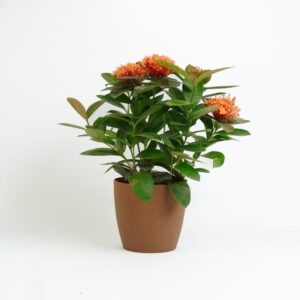 Ixora orange
Ixora orange  Philodendron prince of orange
Philodendron prince of orange  Peperomia
Peperomia  Dracaena Dara singh
Dracaena Dara singh  Succulent
Succulent  Ribbon grass
Ribbon grass  Succulent
Succulent  Ixora Yellow
Ixora Yellow  Bundle Of Office Plants - Aglaonema super white, Scindaspus, Fittonia, sanseveria golden and Alocasia black velvet.
Bundle Of Office Plants - Aglaonema super white, Scindaspus, Fittonia, sanseveria golden and Alocasia black velvet.  Sanseveria
Sanseveria  Cactus
Cactus 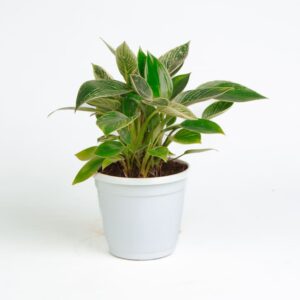 Philodendron birkin
Philodendron birkin 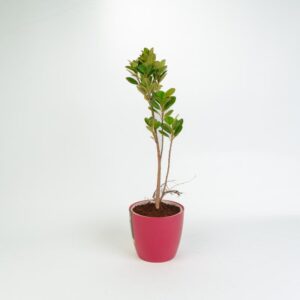 Ficus long island
Ficus long island 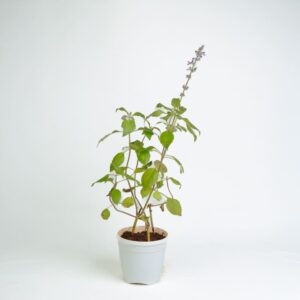 Blue Salviya
Blue Salviya